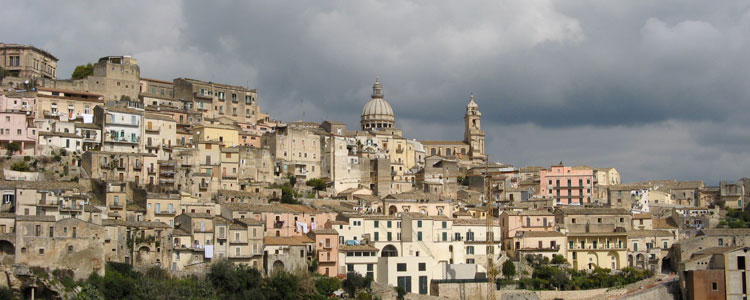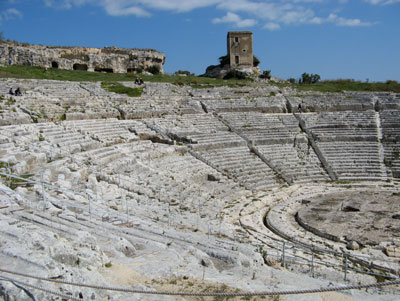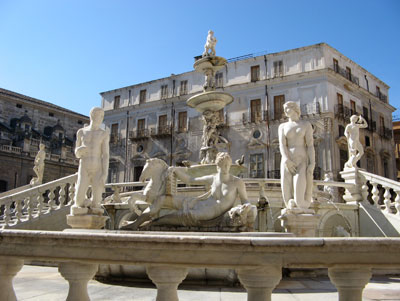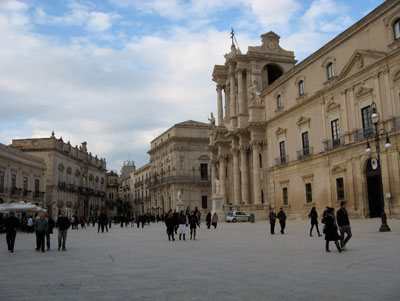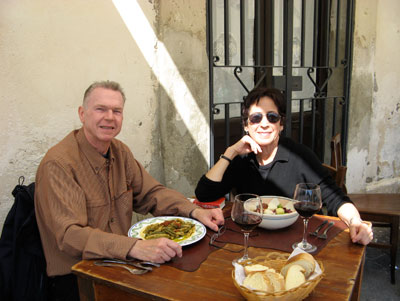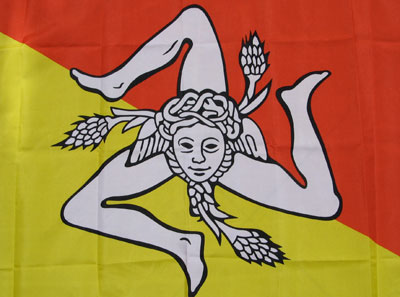Discovering the archaeological and culinary delights of Sicily
Sicily was an easy country to navigate. The drivers were aggressive but no worse than those elsewhere in Europe. Driving in the large cities was not much fun, but the freedom of having a rental car everywhere else made up for it.
by Richard Berner, San Diego, CA
“What is that strange symbol?” my wife, Martha, and I kept asking each other.
As we drove around Sicily in March 2010, we frequently saw this unusual icon: three bent legs radiating like spokes from a woman’s head. We saw it in the souvenir stores and stands, on restaurant menus and even on the island’s flag. Our curiosity piqued, we asked around and were told it was the trinacria, the symbol of Sicily.
The ancient Greeks, who circumnavigated the island and noted the three capes near present-day Marsala, Siracusa and Messina, called the island Trinakrias, loosely meaning “triangle.” The Isle of Man has a similar symbol, minus the Medusa-like head.
Starting out
Our 11 days in Sicily began after an efficient and inexpensive Ryanair flight (E67, or $93, for two including taxes and baggage fees) from Venice to Trapani, located on the west coast of Sicily. We took the airport bus (€4.50, or $6) to the city’s historic center, where we stayed at Ai Lumi (phone +39 0923 540922, www.ailumi.it), on the pedestrian-only Corso Vittorio Emanuele.
Our comfortable room (€80, or $107) in this 18th-century palazzo was more like a small apartment.
After a delicious lunch next door at Tavernetta Ai Lumi, we explored the town center and admired its Baroque architecture. On the north seafront was what remained of the old city wall and a 13th-century portal.
We walked to the Avis office in the morning to pick up our rental car, reserved through Auto Europe (888/223-5555, www.autoeurope.com). Our first venture in the car was to the nearby hilltop town of Erice. It was not far in miles, but most of the drive was up a very steep hill.
Erice is an attractive walled town. We walked along the main street, stopping for one of our best meals of the trip at Ristorante Monte S. Giuliano (Vicolo S. Rocco, 7). We shared spinach crêpes and tonno (tuna) in lemon and olive oil (€36, or $48).
After lunch, we drove south along Sicily’s west coast to Marsala, staying the night at Hotel Concorde (Contrada Strasatti 708/0). The hotel was unremarkable, but we enjoyed the friendly desk clerk, Mauricio. He was a great example of how well you can communicate with someone even though you know very little of the other’s language.
In the morning, Mauricio prepared breakfast for us and insisted we taste his Marsala wine — not our usual habit at breakfast. We had a lively discussion with him on all things Sicilian, including the Mafia.
Agrigento and beyond
Driving in drizzly weather, we continued toward Agrigento on the southern coast of Sicily. At the Colleverde Park Hotel (phone +39 0922 29555, www.colleverdehotel.it), in the Valley of the Temples area of Agrigento, we secured a room with a view of the temples (€85). We could see some of the temples as we drove around the area.
Since it was still raining, we toured the Archaeological Museum (€12,
or $16, including the temples), exploring the temples the following day. This museum contains interesting artifacts from the temples and cemeteries in the area. Most of the displays were captioned in English.
After an excellent buffet breakfast the next morning, we drove to the starting point of the temple tour and walked to the Temple of Juno (Hera). Soon it started pouring rain, so that was the only temple we saw up close — disappointing, as this site is one of the premier archaeological areas of Sicily.
We then drove east toward Ragusa, entering the oldest part of town, Ragusa Ibla. After phoning ahead and taking a few wrong turns, we located our B&B, Le Fioriere (phone +39 0932 621530, www.bblefioriere.it), and parked in their courtyard. Our large room (€65) was simple but comfortable.
Lunch was at Ristorante U’ Saracina (9 Via del Convento), where we had a good meal for €34. We enjoyed the friendly people working there, including the cute little girl of one of the waitresses, who helped with the serving.
We explored the charming Old Town until the brisk weather drove us back to our warm room.
In the morning our host prepared breakfast for us, leaving it in the communal kitchen that we shared with the B&B’s other room. The weather was a bit warmer that day, so we walked around town and stopped to enjoy a cappuccino when we found an open café.
Siracusa
After consulting our Michelin map, we took off for Siracusa, driving through the attractive towns of Modica and Noto along the way. We approached Siracusa and, with the help of some maps I had printed from Google Maps, located the island of Ortygia, just off the mainland.
We called B&B Viaggiatori, Viandanti e Sognatori (phone/fax +39 0931 24781, www.bedand breakfastsicily.it), which had a room available (€60 per night). Simone came on his bicycle to guide us to their building, and the local police were notified that we were hotel guests so that we could park on the island.
We had lunch for €31 at Il Giardino di Epicuro (Largo Gancia N 5), near the hotel. The weather had improved, so we sat outside, with a view of the ocean and the castelo at the tip of the island.
In the evening we shared pizza and wine at Gran Caffè del Duomo on the Piazza del Duomo, then joined the locals in their evening stroll, or passeggiata, through the piazza area.
We liked this charming town and decided to spend two nights there.
Breakfast was served on the rooftop terrace. We enjoyed our coffee and rolls with a spectacular view of the sea and the city.
We inquired at the B&B and they gave us directions to take the free electric bus to the train station, from which we walked to the Parco Archeologico della Neapolis, one of Siracusa’s prime attractions.
We paid our admission of €8 and toured the Roman amphitheater and the Greek theater. Many of the amphitheater’s stones had been taken to be used for other construction, but the Greek theater was in much better shape; it is still in use for performances in the summer.
The best part of this site was the Latomia del Paradiso, or Quarry of Paradise. We wandered through the gardens, avoiding noisy groups, and went into the caves to enjoy the peace and quiet.
Back on Ortygia, lunch was at Taberna Sveva (Piazza Federico di Sveva, 1/2), where we had an excellent meal (€23). I had a local homemade pasta (cavaletti) with almonds, dried tomatoes and nutmeg, the ingredients reflecting some of the Arabic influence in Sicilian cooking.
In and around Cefalù
In the morning we drove north toward Catania, then continued west on SS121 to circle around Mt. Etna. It was a pretty drive through citrus groves and nut orchards, but much of the volcano was shrouded in clouds.
We ate a very good lunch at Hotel Scrivano, on Piazza Loreto, in Randazzo, on the north side of Etna. Both our dishes featured delicious wild mushrooms — mine with pasta and Martha’s with pork loin — and were a bargain at a total of €20 with wine.
We continued down Etna on the very scenic SS116 toward Capo d’Orlando, on the Tyrrhenian coast, then drove west on the Autostrada to Cefalù.
We called ahead to Dolce Vita B&B (phone +39 0921 923151, www.dolcevitabb.it) in Cefalù and secured a room. It was a great place, with a deck overlooking the ocean on the rear of the hotel. Our large, comfortable room cost €50.
Cefalù is a walking town, so that’s what we did. There aren’t many sights except for the charming town, itself. (The Academy Award-winning movie “Cinema Paradiso” was filmed partly in Cefalù.)
We had dinner on the square in front of the Duomo at Ostaria del Duomo (Via Seminario 5). I had a delicious seafood ravioli and Martha had tortellini in brodo (broth). We also shared a salad, all for €38 including wine.
The next day we explored some of the area by car, including the inland town of Mistretta, before returning to Cefalù along the coastal road, SS113, a much more enjoyable drive than the A20 Autostrada.
Dinner was excellent at La Botte (Via Veterani 6), where I had linguini with clams and Martha had stuffed veal rolls. The wine was more outstanding than usual. We also shared a cannolu, a Sicilian specialty, for dessert. The total was €36.
On to Palermo
We drove to Palermo the next morning and turned in the rental car. We called the Allakala B&B (phone +39 0917 434763, www.allakala.it) for a room, which turned out to be our nicest accommodation of the trip — yet, at a low-season rate of €80, not that expensive.
We spent the afternoon following a walking tour from our Lonely Planet guide that included the Piazza Pretoria, featuring what once was known as the “fountain of shame” with its controversial nude statues.
On our second day we toured the Palermo opera house, Teatro Massimo, and walked through the street markets. In the evening we had wine and snacks for €20 at Schiticchio (Piazza Marina 5), near the hotel. It was a perfect place, the smaller portions just right after a large lunch.
In the morning, we took a taxi to the main bus station and bought tickets (€8 each) back to Trapani. The bus was modern and comfortable. We returned to the Ai Lumi for one night. The weather was warmer this time, so we joined the townspeople for their passeggiata in the evening.
Summing up
In the morning, the airport bus took us to Trapani’s Vincenzo Florio Airport (aka Trapani-Birgi) for our Ryanair flight to Milan. After a few nights in Milan, we returned home.
Sicily was an easy country to navigate. The drivers were aggressive but no worse than those elsewhere in Europe. Driving in the large cities was not much fun, but the freedom of having a rental car everywhere else made up for it.
We didn’t have any problem getting rooms without reservations during March. However, the weather was cooler than normal and we had a few days of rain.
People were friendly and many spoke English. Otherwise, we usually found some way to communicate, using our language guide and our limited knowledge of Italian.
Our favorite wine in Sicily was Nero d’Avola.
We carried the Lonely Planet guide to Sicily, which provided most of our lodging choices.
Euros, worth about $1.35 during our visit, were readily available at ATMs everywhere.
If anyone has questions about our trip, please contact me by e-mail c/o ITN.

